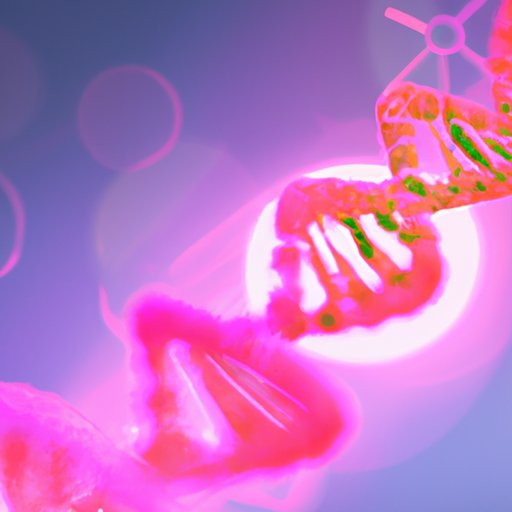Introduction
Recombinant DNA technology is a powerful tool used to manipulate genetic material in order to produce desired characteristics or modify existing ones. This involves taking DNA from one organism and combining it with DNA from another organism in order to create a new, genetically modified organism. In order for this process to be successful, scientists must use a vector to transport the new genetic material into the host cell. Plasmids are one type of vector that is often used in recombinant DNA technology due to their ability to replicate independently inside the host cell.

Exploring the Role of Plasmids in Recombinant DNA Technology
Plasmids are small, circular pieces of DNA that can exist independently of the host cell’s main chromosome. They contain genes that can be expressed by the host cell, allowing for the introduction of new genetic material. Plasmids are commonly used in recombinant DNA technology as they are relatively easy to manipulate and can be easily introduced into the host cell. By introducing a plasmid containing the desired gene into a host cell, scientists can create a genetically modified organism.
In addition to allowing for the introduction of new genetic material, plasmids can also be used to enable successful cloning experiments. Cloning involves creating multiple copies of a single gene or piece of DNA, which requires the use of a vector such as a plasmid. The plasmid carries the desired gene into the host cell, where it is then replicated by the cell’s machinery. This allows scientists to quickly and efficiently create multiple copies of a single gene.
Investigating the Benefits of Using Plasmids to Manipulate DNA
The use of plasmids in recombinant DNA technology offers several advantages over other methods of gene manipulation. Plasmids are relatively easy to manipulate, making them ideal for introducing new genetic material into a host cell. They are also able to replicate independently of the host cell’s main chromosome, meaning that the newly introduced genetic material will not interfere with the cell’s normal functioning. Furthermore, plasmids can be used to create multiple copies of a single gene, allowing scientists to quickly and efficiently create large quantities of a desired gene.
In addition to these advantages, plasmids are also necessary for successful cloning experiments. Without the use of a vector such as a plasmid, it would be difficult to introduce a desired gene into a host cell and even more difficult to replicate it. Plasmids provide an efficient way of introducing and replicating a desired gene, making them essential for cloning experiments.

Comparing Natural and Synthetic Plasmids in Recombinant DNA Technology
Plasmids can be divided into two categories: natural and synthetic. Natural plasmids are found naturally occurring in bacteria and other microorganisms, while synthetic plasmids are artificially created in the laboratory. Both types of plasmids have their own advantages and disadvantages when it comes to recombinant DNA technology.
Natural plasmids are preferred by many scientists due to their stability and reliability. They are also easier to obtain than synthetic plasmids, as they can be extracted directly from bacteria. However, natural plasmids have limited capacity and cannot accommodate large amounts of genetic material. Synthetic plasmids, on the other hand, can be engineered to contain large amounts of genetic material, but they tend to be less stable than natural plasmids.

Introducing the Basics of Plasmids and Their Impact on Genetic Engineering
Plasmids are essential for manipulating genetic material and creating genetically modified organisms. They are small, circular pieces of DNA that can exist independently of the host cell’s main chromosome. Plasmids can be used to introduce new genetic material into a host cell, as well as replicate a desired gene for cloning experiments. Natural plasmids are preferred due to their stability, while synthetic plasmids offer the advantage of being able to contain larger amounts of genetic material.
Plasmids have had a profound impact on the field of genetic engineering, allowing scientists to manipulate genetic material in ways never before possible. With the help of plasmids, scientists have been able to create genetically modified organisms that have improved disease resistance, nutritional value, and other beneficial traits.
Conclusion
Plasmids are an essential part of recombinant DNA technology, used to create genetically modified organisms and enable successful cloning experiments. They are relatively easy to manipulate, able to replicate independently of the host cell’s main chromosome, and capable of carrying large amounts of genetic material. Plasmids have had a profound impact on the field of genetic engineering, allowing scientists to manipulate genetic material in ways never before possible.
The use of plasmids in recombinant DNA technology offers several advantages, including the ability to quickly and efficiently introduce new genetic material into a host cell and clone desired genes. While natural plasmids are preferred due to their stability, synthetic plasmids can be engineered to contain larger amounts of genetic material. Overall, plasmids are an essential component of recombinant DNA technology, offering numerous benefits and potential applications.
(Note: Is this article not meeting your expectations? Do you have knowledge or insights to share? Unlock new opportunities and expand your reach by joining our authors team. Click Registration to join us and share your expertise with our readers.)
